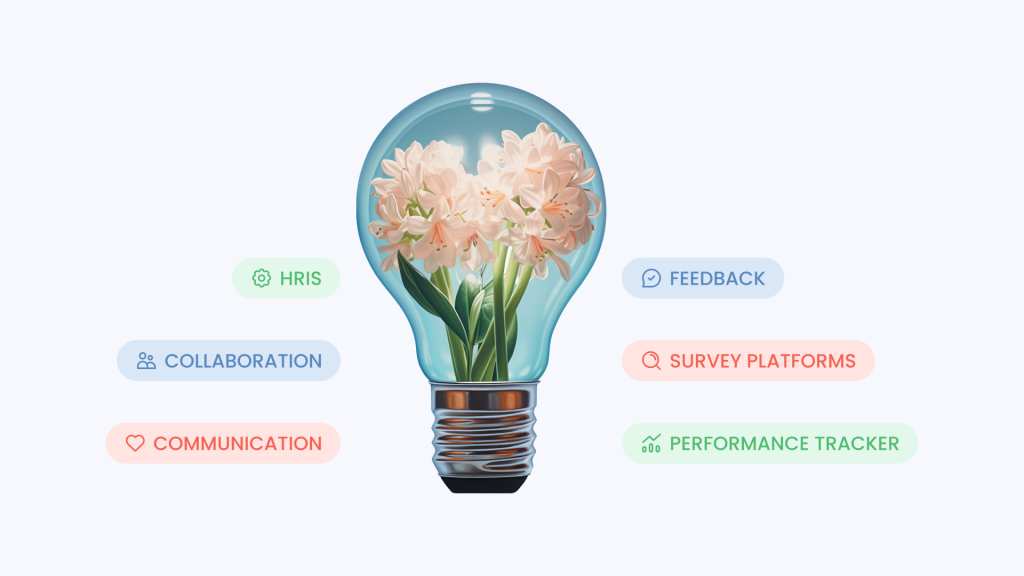According to a PwC global survey of 3,200 workers, “the majority (69%) of senior leaders credit much of their success during the pandemic to culture.” Additionally, 72% emphasize the role of culture in facilitating change initiatives. Notably, as much as 67% of respondents view culture as more important than strategy or operations.
These findings underscore the importance of defining culture in the workplace. In this article, we’ll explore the significance of culture building and offer strategies and tools to help define workplace culture effectively.
What is Culture Building?
Culture building is the art of building a specific atmosphere, particularly the organizational or company culture, which significantly influences how employees and managers operate.
Defining culture in the workplace encompasses a set of shared values, behaviors, beliefs, attitudes and norms that characterize your business. This includes formal rules like policies and traditions, as well as informal practices such as unwritten norms and attitudes. For example, creating a separate chat on your company’s messaging software where employees exchange memes or engage in playful banter, fostering a lighthearted atmosphere.
Why Does Workplace Culture Matter?
Culture building is crucial because it boosts employee engagement, enhances performance and employee well-being, attracts top talent, and hones innovation. This results in lower turnover and absenteeism rates, lower recruitment costs, and a stellar company reputation.
A strong company culture not only fosters client loyalty but also enhances employee performance in customer service, leading to higher revenue and improved client retention.
Identifying Your Company’s Unique Culture
There is no one-size-fits-all when it comes to company culture. Here are some pointers for defining culture in the workplace that will assist you in creating your own unique cultural blueprint.
Observe daily interactions
Begin by observing the everyday interactions within your business. You’ll notice the essence of “culture” reflected in employee communication, the way they commend each other’s contribution, and in all aspects of daily interactions and workflow. That includes management practices, recruitment, terminations, promotions, employee recognition, resolving conflicts, and interactions across various organizational levels.
Consider how management acknowledges the team’s achievements when monthly targets are met. Additionally, observe how teams engage with one another. These interactions offer insight into the level of support and positivity within your work environment, contributing to the definition of workplace culture.
Evaluate employee behavior
Another effective method for defining culture in the workplace is through employee behavior, which can be gauged through metrics such as employee engagement and employee retention rates. Conduct regular employee engagement surveys to evaluate employee engagement levels and identify areas of improvement.
This aspect also intersects with the previous one, as observing daily interactions provides insights into employee behavior. For instance, high levels of absenteeism may indicate a disengaged work environment.
Review company values and mission
Company values and mission play an important role when it comes to defining culture in the workplace, as culture serves as a means through which these values and missions are communicated and achieved. Mission statements articulate the organization’s purpose and goals. Since they are typically documented, it is also easily accessible by employees.
For instance, if transparency is a core value in your company, it may manifest as open communication between employees and the management team. Consequently, this transparency will be reflected in honest marketing practices for your products and services, thereby solidifying client trust.
Collect employee feedback
We previously mentioned the importance of gathering employee feedback through employee satisfaction surveys. Another way of defining culture in the workplace is by directly asking for feedback from team members.
For example, employees may express sentiments that confirm the presence of a supportive company culture, such as:
- “I feel comfortable asking for help.”
- “I’m satisfied with my career growth here.”
In contrast, they might give feedback that signifies a less engaging work environment, such as:
- “I feel stuck in my career.”
- “It doesn’t feel the same anymore.”
Be sure to employ various methods to gather employee feedback and see how they describe your company culture.
Learn more: 15 Employee Engagement Ideas for Company Culture
Analyze physical workspace
The physical workspace refers to elements like size, location, layout, and furnishings. From the office floor plan to the lounge area and even the plant by the window, every aspect contributes to defining culture in the workplace.
The idea revolves around whether your workspace is welcoming, as it directly influences employee well-being, a key factor in defining culture in the workplace. To illustrate, open-plan offices create a collaborative culture, whereas closed-office plans offer more privacy.
Strategies for Establishing Workplace Culture

Having gained insight into your company’s unique culture, the next step in defining culture in the workplace involves determining which aspects to retain or discard. Consider the following strategies to enhance and strengthen your cultural building process.
Define core values
What are the core values, mission, and vision that define your organization? What is its purpose? These are the basics of culture building, outlining your business objectives, methods of achieving them, and principles to follow throughout the process.
Define them as a team to ensure these values align with team goals and resonate with others. Bear in mind that this is a continuous process, as your values may shift and develop over-time. Utilize regular cultural assessments to stay attuned to these changes.
Lead by example
Embodying the core values and leading by example is key to defining culture in the workplace. Demonstrate to your employees how they can embody these values through your interactions with them.
For example, if you aim to foster a culture of diligence, begin by committing fully to your individual tasks. When colleagues observe your dedication, they may feel compelled to uphold their own standards, creating a positive ripple effect throughout the workplace.
Encourage open communication
Open communication is at the heart of culture building. Observing teams with strong communication and collaboration fosters a thriving work culture.
Clearly and consistently communicating your values and mission throughout all levels of the company hierarchy is pivotal. This communication shapes employee behavior within the evolving culture and reinforces community bonds.
It’s important to offer employees opportunities to provide feedback, practice active listening, and provide prompt responses. Utilize internal communication methods such as company newsletters, communication apps with diverse channels, and regular check-ins, particularly beneficial for remote workers, to enhance communication.
Establish clear expectations
Get everyone on the same page by establishing clear performance expectations. What do you need from them in terms of culture building? Address how work is accomplished, the reasons behind tasks, and the expected interactions among team members. These expectations should align with the company mission and core values, defining culture in the workplace.
To exemplify, you might aspire to foster a laid-back atmosphere with work-life balance as a core value. Alternatively, you may aim to cultivate a high-performance culture suited for ambitious individuals willing to invest extra hours. Clear communication of these expectations is key in both scenarios.
Foster team building
Culture thrives with teamwork, yet team-building activities shouldn’t be mandatory. How else can you promote teamwork or collaboration? Consider arranging engaging competitions, off-site retreats, investing in collaborative software tools, and initiating cross-functional projects to encourage cooperation among departments.
Recognize and reward desired behaviors
When employees excel or behave in a way that’s in line with your desired company culture, it is important to recognize and reward them. By doing so, team members are encouraged to repeat such behavior and with others joining it, a positive ripple effect is obtained which helps in defining culture in the workplace.
Wondering how you can craft an effective employee recognition program? Consider implementing reward systems such as “Employee of the Month” initiatives, publicly celebrating exceptional employees in newsletters or weekly gatherings, and utilizing platforms to facilitate peer recognition.
Get inspired: 12 Employee Recognition Examples to Keep Your Team Engaged All Year
Invest in employee development
Providing employees with opportunities for career advancement significantly enhances their commitment to the company, fostering a culture of continuous learning and improvement.
To support employee growth, provide a range of technical and non-technical skill programs, courses, training, and mentorship opportunities. Also, consider recommending qualified team members for promotions when positions become available. Last but not least, develop customized learning plans tailored to each employee’s career trajectory.
Useful Tools for Defining Culture in the Workplace

HRIS
By streamlining your administrative HR tasks with HRIS, HR professionals can allocate more time to culture building activities, enhancing employee value and engagement.
An example of how HRIS can help with defining culture in the workplace is through the automation of employee onboarding. During employee onboarding, streamlined paperwork and administrative tasks facilitate the People team in instilling your business’s core values and welcoming new hires efficiently.
Employee Feedback Tools
Utilizing employee feedback culture building tools that include sentiment analysis, automated reporting and data visualization can help you collect and analyze employee opinions on their work experience.
Another added benefit of empowering team members to submit feedback anonymously is encouraging openness and honest opinions. This aids in defining culture in the workplace by providing insights into the current work environment and assisting in its improvement.
Collaboration and communication tools
Online collaboration tools for internal communication should support real-time communication and user experience. Video conferencing apps and online forums that allow everyone to share their perspectives can boost employee engagement, aiding in culture building and defining culture in the workplace, regardless of where your team members are geographically located.
Performance management software
Performance management software supports goal setting and regular check-ins, analytics generation, quarterly reviews and assessment of employee performance using Objective and Key Results (OKRs). This enables rewarding outstanding performance and re-engaging disengaged employees, contributing to culture building.
Furthermore, it establishes workplace culture centered on continuous career development, allowing you to create a personalized career plan for your team.
Culture Survey Platforms
Last but not least, culture survey platforms fall under the category of employee feedback tools. They play a crucial role in defining culture in the workplace by enabling employees to express their sentiments about their work environment.
Conducting a culture survey gives you an understanding of your employee satisfaction with the work culture, which informs your culture building strategy. Sample questions may include:
- Are you satisfied with the current work culture?
- Which aspects of the work culture should be improved upon?
- Do you feel safe in this work environment?
- Do you feel that management acts upon your feedback?
Empowering Teams for Health and Wellbeing
A strong culture nurtures a fulfilling atmosphere where employees are satisfied and fully involved, resulting in increased productivity and favorable results. The optimal focus for defining culture in the workplace lies in the employee onboarding process, with HR solutions like Omni serving as the ideal tool.
Omni’s all-in-one employee management software unifies the tools, workflows, and data you need to streamline your HR functions while you build an award-winning culture.
Omni offers a solution that combines people and performance management and workflow automation to manage the end-to-end employee lifecycle. Wherever you are in your journey, Omni has a module that suits your needs. With our customer care supported implementation process, you can tap into increased engagement levels for your new hires, setting the stage for their long-term success within your organization while receiving world-class support from our attentive support team.
Let Omni help you build a culture that increases productivity and drives impactful business outcomes. Book a demo with our team to learn more.


